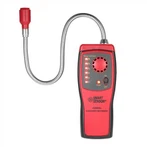The structure and working principle of pointer type clamp pointer meter
Clamp ammeters can generally be divided into two categories: magnetoelectric and electromagnetic. Among them, the one that measures power frequency alternating current is the magnetoelectric type, while the electromagnetic type is both AC and DC. This article mainly introduces the measurement principle and use method of magnetoelectric clamp ammeter.
1.Magnetic clamp ammeter structure
The magnetoelectric clamp ammeter is mainly composed of a special current transformer, a rectifier magnetoelectric ammeter and internal circuits. Generally common models are: T301 type and T302 type. The T301 type clamp ammeter can only measure AC current, while the T302 type can measure both AC current and AC voltage. There are also pocket clamp ammeters for AC and DC, such as MG20, MG26, MG36 and other models.
2. Working principle of clamp ammeter
The working principle of the clamp ammeter is based on the working principle of the current transformer. When the clamp ammeter wrench is held tightly, the core of the current transformer can be opened, and the wire of the measured current enters the inside of the jaw as a current mutual inductance. primary winding of the device. When the iron core of the loosening wrench is closed, an induced current is generated on its secondary winding according to the principle of the transformer, and the ammeter pointer deflects, thereby indicating the value of the measured current.
It is worth noting that since its principle is based on the principle of transformer, whether the iron core is tightly closed and whether there is a large amount of residual magnetism will have a great impact on the measurement results. When measuring a small current, the measurement error will increase. At this time, the wire under test can be wound around the core a few more times to change the current ratio of the transformer to increase the current range. At this time, the measured current Ix should be:
Ix=Ia/N
In the formula, Ia is the reading on the ammeter; N is the number of winding turns.
3. How to use clamp ammeter
(1) Select the clamp ammeter correctly according to the type and voltage level of the current being measured. Generally, for lines with AC voltage below 500 V, type T301 is used. When measuring the current of a high-voltage line, a high-voltage clamp ammeter that matches its voltage level should be used.
(2) Correctly check whether the appearance of the clamp ammeter, the closing condition of the jaws and the condition of the meter head are normal. If the pointer is not at zero, mechanical zero adjustment should be performed.
(3) Select the appropriate range of the clamp-type ammeter according to the size of the measured current. The selected range should be slightly larger than the measured current value. If the magnitude of the current being measured is not known, the maximum range should be used for estimation first.
(4) Measure correctly. When measuring, press the wrench tightly to open the jaws. Place the wire under test into the center of the jaws, loosen the wrench and close the jaws tightly.
(5) After reading, open the jaws, withdraw the wire under test, and set the gear to the highest current level or OFF gear.
Measurement example: Measure the operating current of a cage-type asynchronous motor during operation. According to the current size, you can check and judge whether the motor is working normally to ensure the safe operation of the motor and extend its service life. First, correctly select the voltage level of the clamp-type ammeter, check whether its insulation is good, whether it is damaged, whether the pointer swings flexibly, and whether the jaws are rusted, etc. Estimate the rated current based on the motor power to select the range of the meter. When measuring, you can measure once for each phase or once for three phases. At this time, the number on the meter should be zero (because the sum of the three-phase current phasors is zero). When there are two phase wires in the clamp, the meter will display The value is the current value of the third phase. By measuring the current of each phase, it can be judged whether the motor is overloaded (the measured current exceeds the rated current value). The power supply voltage inside the motor or (a device that converts other forms of energy into electrical energy is called a power supply) Is there any problem, that is, whether the three-phase current imbalance exceeds the 10% limit.






